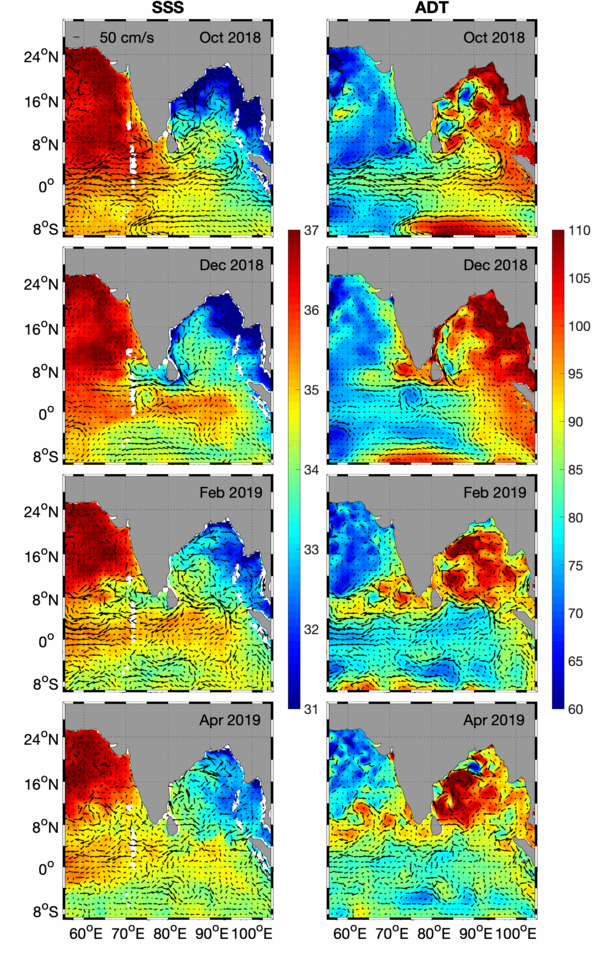2019 monsoon monitored using altimetry
Image of the Month - November 2019

Monsoons are affecting about half of the Earth’s human population. They occur every year, but with high interannual variability, so their consequences ranges from usual to catastrophic (either too much or not enough rain, in particular). Thus predicting monsoon in advance to mitigate the potential effects is foremost for the countries impacted. In particular, 2019’s wet monsoon was quite unusual in India: starting slower than usual, it then began to rain much more than the average and continued in October, later than normal.
Altimetry enables to follow and understand the sequence of events, in conjunction with other remote sensing data. In particular, Absolute Dynamic Topography in the southeastern Arabian Sea shows a height (The Lakshadweep High), which guides the low salinity water into the region. This feature allows for a layer of low salinity to be formed along the southwestern coast of India near Kerala. This causes stable stratification and the formation of a barrier layer, which in turn warms much faster than the surrounding ocean, creating the Arabian Sea Mini Warm Pool and allowing for the genesis of the monsoon onset vortex that triggers the onset of the monsoon over Kerala.
Using all Earth observation data to better understand ocean phenomena enable to better forecast them in the future, so as to mitigate the effects. The continuity of satellite altimetry in particular provides with long-term observation of coupled ocean-atmosphere events.
View also the animation showing daily precipitation, ADT, SST and SSS from the monsoon onset (day 1) to 51 days later.
See also:
- Image of the Month, Dec. 2012: Winds and currents around India
- Image of the Month, Oct. 2002: Summer current, winter current
- Image of the Month, Aug. 2004: Summer: wet monsoon season
- Data : CMEMS Global ocean gridded L4 sea surface heights and derived variables NRT
References:
- Roman-Stork, H. L., Subrahmanyam, B., & Murty, V. S. N. (2019). Quasi-biweekly oscillations in the Bay of Bengal in observations and model simulations. Deep-Sea Research Part II: Topical Studies in Oceanography, (June), 104609. https://doi.org/10.1016/j.dsr2.2019.06.017
- Roman-Stork, H. L., Subrahmanyam, B., & Trott, C. B. (2019). ScienceDirect Mesoscale eddy variability and its linkage to deep convection over the Bay of Bengal using satellite altimetric observations. Advances in Space Research. https://doi.org/10.1016/j.asr.2019.09.054
- Trott, C. B., & Subrahmanyam, B. (2019). Detection of intraseasonal oscillations in the Bay of Bengal using altimetry. Atmospheric Science Letters, 1–10. https://doi.org/10.1002/asl.920
- Trott, C. B., Subrahmanyam, B., Roman-Stork, H. L., Murty, V. S. N., & Gnanaseelan, C. (2019). Variability of Intraseasonal Oscillations and Synoptic Signals in Sea Surface Salinity in the Bay of Bengal. Journal of Climate, 32(20), 6703–6728. https://doi.org/10.1175/jcli-d-19-0178.1




